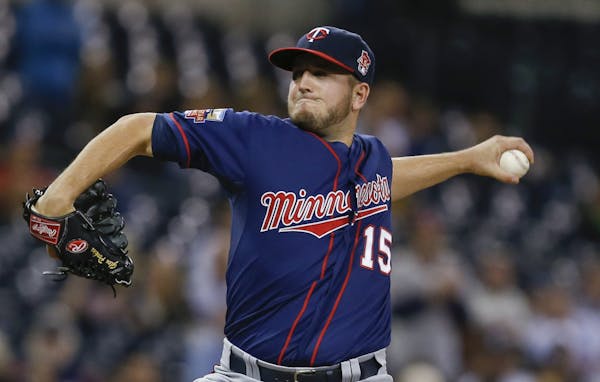FORT MYERS, Fla. – Some people admire masterpieces in art museums, some people in opera halls or Broadway theaters. Torii Hunter says he once saw one while standing in center field in Cleveland.
And he remembers his overriding emotion that day was pity — not for the artist, but for his victims.
"I felt sorry for [the Cleveland Indians], because I knew it was going to be a tough day for them," Hunter said. "After two innings, I said, 'They've got a big problem.' "
That's because Ervin Santana was on the mound for the Angels, and "his breaking ball was just exploding. I could see it from out there," Hunter said. "It was impressive. He had the slider working, he's throwing 94, 95 [miles per hour], he was hitting his spot on both sides. And he just had guys fooled."
Santana rode his repertoire that July day in 2011 to a no-hitter, the Angels' first in 27 years, with Hunter scoring the decisive run on a passed ball. Four years later, they are teammates again, the Twins' prized acquisitions of the offseason.
Santana, signed in hopes he joins Phil Hughes as a stabilizing force atop the rotation, threw his first bullpen session with the Twins on Tuesday, testing all four of his pitches in front of new pitching coach Neil Allen, while Hunter took batting practice on a nearby diamond. And while they are both now on the backside of their careers, Hunter has no doubt that the Dominican righthander can be just as effective today, even if the breaking ball isn't quite as explosive, even if the velocity isn't quite as breathtaking.
"You get older, everything slows down a little bit, but you make up for it by getting smarter. You figure out ways to be better," Hunter said of Santana, 32. "He's more mature now. When he was throwing 96-97, he was just throwing. Now, he's locating it, he knows how to get out of jams. I'm excited he's on this team."
If you think Hunter is excited, imagine Kurt Suzuki's emotion. He no longer has to face Santana.
"Yeah, I'm aware. What is it, 2-for-35?" Suzuki said of his history against Santana, which is actually three singles in 36 at-bats, a .083 average. "I guess I sold myself short," he laughed. "For me, it was always that slider — it always gave me problems. He moves it around, and I just never got anything to hit."
He's not the only one.
"Do I remember him? Yeah, I remember that slider that I couldn't hit," said Brian Dozier, 0-for-7 lifetime against Santana. "I can see why now, too. He's got great stuff, but he's all about competing. He's a bulldog. You can see it, when he steps on the mound, he thinks he's unhittable."
If so, he's sometimes incorrect, because Santana is no Clayton Kershaw. Since he arrived in the majors in 2005, only four pitchers — Mark Buehrle, Bronson Arroyo, A.J. Burnett and Dan Haren — have given up more runs than Santana's 937, and all four pitched more innings. But Santana has posted an ERA below 4.00 in four of his past five seasons, too, and he said he feels like a better pitcher today.
"When you're younger, you just want to blow everybody out with the fastball. But you start to learn a little more how to pitch, how to get guys off-balance," he said. "I have more confidence now that I can throw any pitch in any count."
Hits happen, he said; his secret is maintaining his composure when they do.
"I'm calm, I'm OK. If I give up home runs, I don't go crazy," said Santana, who signed a four-year, $55 million contract in November, the richest free-agent contract in Twins history. "If you're good and hit a good pitch, I tip my cap, good job. But I don't yell at myself or anything. I go get the next guy."
That serenity extends to his entire outlook, Santana said; he's always smiling in the clubhouse and has already established himself as a positive presence among his teammates. His manager, too.
"[He told me], 'Whatever you want. I'm OK pitching wherever you want me in the rotation,' " Paul Molitor said. "The only [time] you might have trouble with me is, I don't like coming out of games.' Which is pretty horrible for a manager to hear," Molitor added with a laugh.
